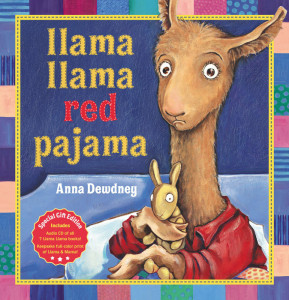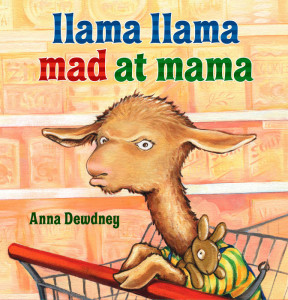I sometimes fantasize about living in an old farmhouse with lots of dogs, chickens and other animals—like, say, llamas. But recently when I searched my library for books about raising llamas, I came up empty.
What did turn up was a slew of Llama Llama books by Anna Dewdney.

Okay, folks, where have I been?
Although I’d heard of Llama Llama Red Pajama, I’d never actually read it. And I had no idea this book was merely the front end of a publishing juggernaut that includes a string of picture books, board books, apps, audiobooks, and at least one plush toy.
Now I was curious. What is it that made these books so successful—well-reviewed, best-selling, and immensely popular (nearly all were checked out at my library, with multiple holds)?
After reading four of them (admittedly, a small sampling—there are many, and more to come), I have a few ideas. Here goes:
Believable—and endearing—characters. Little Llama is not a perfect child; he gets impatient, has tantrums, and doesn’t always want to share. Mama gets tired and cranky sometimes, too. They may be llamas, but their emotions feel very human and relatable.
Familiar situations. The books deal with the ordinary situations and struggles of everyday life—play dates, bedtime fears, being sick, waiting. In Llama Llama Mad at Mama, Llama battles boredom at the “Shop-O-Rama.” Note the child’s eye view:
Yucky music,
great big feet.
Ladies smelling way too sweet.
Look at knees and stand in line.
Llama Llama
starts to whine.
Funny. Llama’s whining at the grocery store turns into a full-blown chuck-everything-from-the-cart tantrum. While a few kids (or parents) might be a tad mortified by his actions, most will find the slapstick action hilarious (my son at age three certainly would have):
Flying pasta,
spraying juice.
Paper towels rolling loose.
Coffee, bread, and chips galore.
Shoes and sweaters
hit the floor.
CRASH the cart and SMASH the signs.
No more waiting! NO more lines!
Out go socks and Cheezee Puffs . . .
Llama Llama,
That’s enough!
Fun to read aloud. The texts are brief—the two I typed were 250 and 350 words—and the verses short, simple and rhythmic, with lots of catchy phrases and repetition. (Warning: you may find phrases repeating themselves in your brain hours later.) Here’s a snippet from Llama Llama Red Pajama:
Llama Llama
red pajama
waiting waiting
for his mama.
Mama isn’t
coming yet.
Baby Llama
starts to fret.
Expressive illustrations. The art adds context, details and plenty of action to the spare text, and those big, expressive llama eyes show a wide range of emotion—fear, worry, boredom, remorse, impatience, affection.
Lots of love and tenderness. Despite exhaustion and occasional exasperation, Mama Llama clearly loves her little one—and vice verse.
I’m not sure how I missed these books, but it probably had to do with timing—my son had mostly moved on to chapter books when the first was published in 2005. Which brings me to perhaps the strongest testament to the appeal of these books: They stirred up so many memories of the sweet and funny—but not always easy—early childhood era that when I looked (way up) at my 17-year-old son the other day, I saw my own adorable little Llama.
Got a favorite Llama Llama book? Or some experience raising real llamas? Please share!

And, now, to follow up on my last post, the winner of an autographed copy of Zachariah OHora’s new book,
My Cousin Momo, is . . .
Beverly Crawford!!
Thanks, everyone, for all the great comments. We love hearing from you.


I think the Llama books are very fun to read aloud, and you made some good points. Very “relateable” to kids!
Thanks, Tina!
Thanks for your insights!
Thanks for stopping by, Elizabeth!
No fret, Linda. The super popular titles stay on the shelves for years! There’s always time to fill in any gaps.
Very true. Thanks, Linda!
I haven’t read any of these either, but with a new grandson may have just the excuse. 🙂
Oh, fun! These will be perfect, Quinette!
I agree, these books are great mentor texts on how to write a successful picture book. Look forward to reading My Cousin Momo.Thanks for sharing!
Thanks, Danielle!
The “Llama” books are fantastic fun. And author/illustrator Anna Dewdney is such an inspiration. I first learned of SCBWI from her when she said joining was essential to learning to write for children.
Yes, joining SCBWI is excellent advice. And, yes, definitely an inspiration!
Thank you, Linda, for reminding me of how much there is to learn from this successful “series.” I love these books, and now I know why!
Thanks, Anne. They’re definitely lovable!
Aw, these books are SO cute. The titles alone pull me right in.
I know–catchy, right? Very cute.
As a retired reading specialist, I volunteer in a neighborhood preschool. I’ve had the best time reading all the LLAMA books aloud to the preschoolers.
Hi, Kathy–they seem perfect for preschoolers. I’m sure they love them!
It’s irony that publishers don’t like receiving rhyming texts. (Understanding that MOST aren’t good.) But when they are good, they are sellers. Children love them and I think parents enjoy reading them, too. I did.
Several posts ago someone recommended a book, Who Took the Farmer’s Hat. I LOVED it! Thank you. This 1963 classic is still selling as a paperback and I’ll be promoting it on my picture book blog. I even typed it up! The story, In brief: the farmer loses his hat and every animal he asks says he hasn’t seen a hat, but he or she saw a: fat, round flying bird in the sky, or big round brown mousehole in the grass, or a silly round brown boat. Each one described from their perspective how they saw the brown hat. A brilliant book. Surprised they haven’t re-published it.
This blog is great. So many insights, recommendations (good ones!) and so much to learn. Thank you, team for providing the blogs!
Susan
Love the Llama Llama books too. Grab them when I see them, and yes, rhyme (good rhyme) works with kids,,,because it’s reliable for them and their mental reading process, and that’s why they like it.
Susan, gotta find that book…never heard of it, but what a fun search for a lost hat.